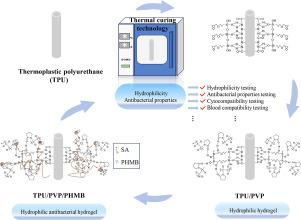Hydrophilic-antimicrobial dual-function modification of TPU catheter based on sodium alginate and cationic composite coating
IF 5.1
3区 工程技术
Q1 CHEMISTRY, APPLIED
引用次数: 0
Abstract
This study investigates the clinical challenges associated with conventional catheters, particularly bacterial adhesion and catheter-associated infections (CAI), which are exacerbated by surface hydrophobicity. To address these issues, a functional modification strategy for thermoplastic polyurethane (TPU) catheters was developed, leveraging the complexation between sodium alginate (SA) and the cationic antimicrobial agent poly (hexamethylene biguanide) hydrochloride (PHMB) to construct a dual-functional composite coating system with combined hydrophilicity and antibacterial properties. A hydrophilic coating was first formed on the TPU surface using 3-glycidoxypropyltrimethoxysilane (KH-560) and polyvinylpyrrolidone (PVP), significantly reducing surface hydrophobicity. Simultaneously, the anionic properties of SA were utilized to complex cationic antimicrobial agents, forming a long-lasting antibacterial functional layer. The modified catheter exhibited a reduction in the coefficient of friction from 1.3 to 0.03, corresponding to a 53 % improvement in lubricity. Compared to unmodified catheters, the coating introduction showed no significant impact on maximum tensile force or hardness, but slightly reduced the bending modulus, enhancing adaptability in vascular environments. Zone of inhibition assay confirmed the strong antimicrobial efficacy of the hydrophilic-antibacterial coating against Escherichia coli (E. coli) and Staphylococcus aureus (S. aureus). Additionally, cytocompatibility and hemocompatibility verified the biosafety of the modified catheters. By optimizing the composite coating modification, this study successfully achieved efficient synergy between hydrophilicity and antibacterial properties in TPU catheters, providing an innovative solution to reduce the risk of CAI.

基于海藻酸钠和阳离子复合涂层的TPU导管亲水抗菌双功能改性
本研究探讨了与传统导管相关的临床挑战,特别是细菌粘连和导管相关感染(CAI),这些感染会因表面疏水性而加剧。为了解决这些问题,研究了热塑性聚氨酯(TPU)导管的功能改性策略,利用海藻酸钠(SA)与阳离子抗菌剂聚六亚甲基双胍盐酸盐(PHMB)的络合作用,构建了具有亲水性和抗菌性能的双功能复合涂层体系。首先用3-缩水氧基丙基三甲氧基硅烷(KH-560)和聚乙烯吡咯烷酮(PVP)在TPU表面形成亲水性涂层,显著降低了表面疏水性。同时,利用SA的阴离子特性与阳离子抗菌剂配合使用,形成长效抗菌功能层。改进后的导管显示摩擦系数从1.3降低到0.03,相应的润滑改善了53%。与未修饰的导管相比,涂层的引入对最大拉伸力和硬度没有显著影响,但弯曲模量略有降低,增强了导管在血管环境中的适应性。抑菌区实验证实亲水性抗菌涂层对大肠杆菌(E. coli)和金黄色葡萄球菌(S. aureus)具有较强的抑菌效果。此外,细胞相容性和血液相容性验证了改良导管的生物安全性。本研究通过优化复合涂层改性,成功实现了TPU导管亲水性和抗菌性能的高效协同,为降低CAI风险提供了创新的解决方案。
本文章由计算机程序翻译,如有差异,请以英文原文为准。
求助全文
约1分钟内获得全文
求助全文
来源期刊

Reactive & Functional Polymers
工程技术-高分子科学
CiteScore
8.90
自引率
5.90%
发文量
259
审稿时长
27 days
期刊介绍:
Reactive & Functional Polymers provides a forum to disseminate original ideas, concepts and developments in the science and technology of polymers with functional groups, which impart specific chemical reactivity or physical, chemical, structural, biological, and pharmacological functionality. The scope covers organic polymers, acting for instance as reagents, catalysts, templates, ion-exchangers, selective sorbents, chelating or antimicrobial agents, drug carriers, sensors, membranes, and hydrogels. This also includes reactive cross-linkable prepolymers and high-performance thermosetting polymers, natural or degradable polymers, conducting polymers, and porous polymers.
Original research articles must contain thorough molecular and material characterization data on synthesis of the above polymers in combination with their applications. Applications include but are not limited to catalysis, water or effluent treatment, separations and recovery, electronics and information storage, energy conversion, encapsulation, or adhesion.
 求助内容:
求助内容: 应助结果提醒方式:
应助结果提醒方式:


